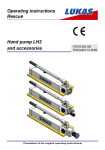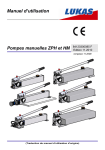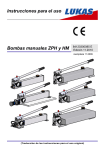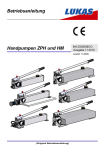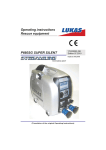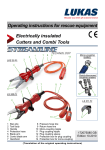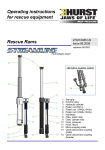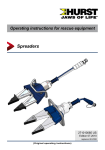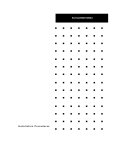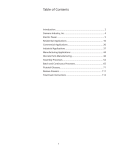Download Operating instructions Hand Pumps ZPH and HM
Transcript
Operating instructions Hand Pumps ZPH and HM 84120300085 GB Edition 11.2010 replaces 11.2009 (Translation of the original operating instructions) 2 Contents Page 1. Danger classes 4 2. Product safety 4 3. Proper use 7 4. Main components of the hand pump 8 5. Functional description 8 6. Connection options for hydraulic equipment 9 6.1 Connecting nipples 9 6.2 Quick-disconnect couplings 10 6.3 Monocouplings 11 7. Commissioning 12 7.1 Locking the pump 12 7.2 Bleeding the pump 12 8. Operation 13 8.1 Operation 13 8.2 Shut-down / Storage 14 9. Transport 14 10. Maintenance and repair 14 10.1 Basic requirements 14 10.2 Maintenance 15 10.3 Changing or topping up the hydraulic fluid 16 10.4 Care 16 10.5 Repair 17 11. Troubleshooting 22 12. Technical data 25 12.1 Hand pump data 25 12.2 Hydraulic fluid recommendation 28 12.3 Operating and storage temperature ranges 28 13. EC Declaration of Conformity 29 14. Notes 30 3 1. Danger classes We distinguish between various categories of safety instructions. The table shown below shows you the overview, via the assignment of symbols (pictograms) and signal words, of the concrete danger and the possible consequences. Pictogram Damage / injury to Key word human DANGER! Definition Consequences Immediate danger Death or major injury WARNING! Potentially dangerous situation Potential death or major injury CAUTION! Less dangerous situation Minor or slight injury device Damage to the Danger of damage equipment, damage ATTENTION! to device / to the environment, environment damage to surrounding materials - NOTE Advice for application and other important / useful information and advice No injury / damage to persons / environment / equipment Wear helmet with face guard Proper recycling Wear protective gloves Protect the environment Read and follow operating instructions Wear safety shoes 2. Product safety LUKAS products are developed and produced in order to ensure the best performance and quality with proper use. The safety of the operator is the most important consideration in the product design. In addition, the operating instructions are to help in using the LUKAS products safely. In addition to the operating instructions, all generally applicable, statutory and other binding rules for accident prevention and for environmental protection must be heeded and disseminated. The device must only be operated by educated persons who are trained in safety technology, since otherwise there is a risk of injury. We advise all users before using the device to carefully read through the operating instructions and to follow the instructions contained therein without exception. 4 We also recommend that you get instructed by a qualified trainer in the use of the product. WARNING / CAUTION! The operating instructions for the hoses, the accessories and the connected devices must also be heeded! Even if you have already received instruction, you should read the following safety instructions again. Make sure that no body parts or clothing get between the openly visible moving parts of the device. Immediately report changes that occur (including changes in operating behaviour) to the appropriate persons/ departments! If necessary, immediately shut down and secure the device! Wear protective clothing, protective helm with visor, safety shoes and protective gloves. Check the device for visible defects or damage before and after use. Working under loads is prohibited if they are raised exclusively with hydraulic devices. If this work is unavoidable, sufficient mechanical supports are additionally required. Check all lines, hoses and screwed connections for leaks and externally visible damages and repair immediately! Escaping hydraulic fluid can lead to injuries and fires. In the event of malfunctions, shut down the device immediately and secure it. You should have the malfunction repaired immediately. Do not make any changes (add-ons or conversions) on the device without the approval of LUKAS. Heed all safety instructions and hazard warnings on the device and in the operating instructions. All safety instructions and hazard warnings on the device are to be kept intact and in a legible condition. Make sure that all safety covers are present on the device and in proper working condition. Any work procedure that detracts from the safety and/or stability of the device should be abandoned! Safety equipment must never be disabled! The maximum permissible operating pressure must not be changed. 5 Before switching on/engaging the device or while operating the device, it must be ensured that no one is endangered by the operation of the device. Observe all intervals that are prescribed or specified in the operating instructions for recurring tests and/or inspections. When working in the vicinity of live components and lines, take appropriate measures for preventing current transfers or high voltage flashovers to the device. For repairs only original LUKAS accessories and spare parts are to be used. Prevent electrostatic discharge, which has the possible consequence of spark formation, when handling the device. When the hand pumps are set up, care needs to be taken that they are not impaired by extremely strong temperature changes. The device is filled with hydraulic fluid. These hydraulic fluids can be detrimental to health if they are swallowed or their vapours are inhaled. Direct contact with the skin should be avoided for the same reason. Also, when handling hydraulic fluids, note that they can negatively affect biological systems. When operating and/or storing the device, make sure that the function and the safety of the device are not impaired by strong external temperature differences or that the device is damaged. Keep in mind that the device can also heat up when it is continuously used. Make sure there is adequate lighting while working. Before transporting the device, always check to see that the accessories are positioned securely to prevent the possibility of an accident. Always keep these operating instructions easily accessible at the site where the device is used. Make sure you properly dispose of all removed parts, leftover hydraulic fluid, leftover oil and packing materials. Make sure that you do not get caught in the hose loops and trip when working with or transporting the device. In addition to the safety instructions of these operating instructions, all generally applicable, statutory and otherwise binding national and international rules for accident prevention need to be heeded and disseminated! 6 WAR N IN G / C A U TION / AT T E NT I O N! The device is specified exclusively for the purpose represented in the operating instructions (see Chapter "Proper use"). Any use that differs or goes beyond this is considered improper. The manufacturer/supplier shall not be held liable for damages resulting from improper use. The risk shall be borne solely by the user. Proper use also includes heeding the operating instructions and complying with the inspection and maintenance requirements. Never work in a fatigued or intoxicated state! 3. Proper use The LUKAS hand pump is used for the operation of LUKAS devices. They can be used as an additional or replacement drive source along with the LUKAS hydraulic unit (e.g. in areas at risk for explosion). Use with equipment of other manufacturers is possible, but requires technical testing and approval of LUKAS on a case-by-case basis. WARNING / CAUTION / ATTENTION! Always note the product limitations with respect to operating pressure, load limit values and operating conditions. The operating pressure should not be higher than the lowest maximum operating pressure of any system components. The operating pressure should NEVER be set higher than that which is specified in the "Technical Data" chapter. A higher setting may cause property damage and/or injuries. Make sure that the usable capacity of the hand pump (see chapter "Technical Data") is sufficient for operating the connected cylinders or devices. The required hydraulic fluid operating quantity can be found in the chapter "Technical Data" or in the operating instructions of the devices to be operated. You can obtain accessories and replacement parts for the devices from your authorised LUKAS dealer! 7 4. Main components of the hand pump 5 9 5 10 1 3 11 12 1 5 13 6 2 7 4 1 5 8 1 1 2 3 4 5 6 7 8 9 10 11 12 13 Drain valve Bleeding / Filling cap Pump lever Tank Lock Connecting nipples Sealing caps quick-disconnect couplings (optional) Connecting block for monocoupling (optional) Monocoupling (optional) Front foot plate (optional) Rear foot plate (optional) Base plate (optional) 5. Functional description All LUKAS hand pumps of this series are two-speed, i.e. they have two operating speeds: • A high speed in the low pressure range (LP) for fast extension of the cylinder or device while unloaded • A low speed in the high pressure range (HP) for controlled extension of the cylinder or device while loaded The switch from low pressure (LP) to high pressure (HP) is automatic at the factory setting for changeover pressure (see chapter "Technical Data"). 8 A pressure connection "P" and a return connection "T" with a G1/4“ thread are available for connecting directly to the pump. To connect equipment, appropriate connectors (connecting nipples, quick-disconnect couplings or monocouplings) must be attached. On some of the LUKAS hand pumps offered, one of these connection options is supplied with the pump and is already fitted. Obviously, the connection options fitted can be replaced by others. However, you must contact an authorised LUKAS dealer or contact LUKAS directly. Additionally, LUKAS hand pumps can be fitted with various accessories (e.g. a baseplate), to adapt the hand pump to the individual application. You can obtain the appropriate accessory and any necessary replacement parts for the hand pumps from your authorised LUKAS dealer. 6. Connection options for hydraulic equipment ATTENTION! Make sure to store all plugs, screw plugs and/or dust caps in a way that prevents them from getting dirty or lost. After completion of the work, seal off all lines using screw plugs and/or dust caps to prevent contamination of the hand pump. When connecting lines to the hand pump, we recommend positioning it vertically so that the ports point upward. This reduces the danger of hydraulic fluid escaping. 6.1 Connecting nipples The hose lines are connected via fittings to the hydraulic pump. 1. First remove the closure caps from the fittings. 1. 2. 2. Then, you can connect the hose lines to the fittings and tighten them with a tightening torque of MA = 40 Nm. ATTENTION! The return hose must always be connected at the "T" port of the connection block. The supply hose line must instead be connected at the "P" port. 9 6.2 Quick-disconnect couplings The hose lines are connected via quick-disconnect coupling halves (female and male) to the hydraulic pump in such a way that they cannot be reversed. X Y Before connecting the couplings, remove the dust cap, then pull back and hold the locking sleeve of the female coupling (Position X). Push the male and female couplings together and release the locking sleeve. Finally, turn the locking sleeve into Position Y. The connection is then made and secured. Decoupling is done in the reverse sequence. ATTENTION! Always connect the return line first and then the supply line! NOTE: Coupling the equipment is only possible if the hoses are depressurised. For dust protection, the supplied dust caps must be reattached. WARNING / CAUTION / ATTENTION! To some extent the quick-disconnect couplings have special functions and therefore must not be unscrewed and/or interchanged! 10 6.3 Monocouplings The hose lines are connected via monocoupling halves (female and male) to the hydraulic pump in such a way that they cannot be reversed. Dust caps Male coupling Female coupling Before coupling, remove dust caps, then connect male and female couplings and turn locking sleeve of the female coupling in direction "1" until the locking sleeve latches. The connection is then made and secured. The decoupling is accomplished by turning the locking sleeve in direction "0". The coupling of the devices under pressure is also possible, assuming the connected equipment is not turned on. NOTE: We recommend, when ambient temperatures are low and extension hoses are used, connecting the coupling halves in a depressurised state because decoupling may otherwise require a very large exertion of force. For dust protection, the supplied dust caps must be reattached. WARNING / CAUTION / ATTENTION! The monocouplings must not be unscrewed and/or the hose lines reversed! 11 7. Commissioning NOTE: With the LUKAS hand pump, a little idle stroke may occur when the unit is first used in the high pressure range. However, this idle stroke independently stops after a device is operated 2-3 times. ATTENTION! The hand pump should be as close to horizontal as possible, because otherwise the usable amount changes! The oil fill plug must always be unscrewed one turn before starting operation of the hand pump! This enables the aeration and bleeding of the hydraulic tank. After the work is completed but before transport, the oil fill plug should be retightened! 7.1 Locking the pump Unlock: Lock: ATTENTION! Always push the locking lever fully to the end position, both when locking and when unlocking! When locking the hand pump, the pump lever must always be in the home position (end position against the pump body)! 7.2 Bleeding the pump 1. Open the discharge valve. 2. Open the oil fill screw plug on the tank container and check the oil fill level. The oil fill level should come up to approximately 1-2 cm below the top edge of the oil reservoir. 3. In this state, work the pump handle several times. Hand wheel 12 NOTE: To bleed connected equipment, make sure that the highest point of the connected devices are below the level of the pump. Before operating the pump, you should also open the oil fill screw plug. Only in this way can any trapped air escape the hydraulic system when the pump is operated. You should operate the connected equipment several times without load. When you do this, also follow the separate operating instructions of the connected devices. 8. Operation WARNING / CAUTION! Under certain circumstances, the pump handle can "kick back". Make sure that your body remains to the side of the pump. ATTENTION! Never attach an extension to the pump handle that does not belong to the device. These extensions usually cause the pump to become unstable during operation. NOTE: In order to limit the required force in high pressure operation, we recommended using short strokes with the pump handle. The greatest pumping effect is produced in the last 5 degrees of the stroke. Should you use a female quick-disconnect-coupling as the port, quick stop may be triggered if the discharge valve is opened too quickly (turning counter-clockwise), i.e. the check valve incorporated in the male quick-disconnect coupling blocks the return flow of oil while the connection between pump and female quickdisconnect coupling is depressurised. This is provided as a safety function in case the connection between the female quick-disconnect-coupling and pump starts to leak and the pressure drops abruptly. In this case, the "quick stop" prevents, for example, an abrupt drop in the load when an hydraulic cylinder is operated. In order to release the quick stop again, more pressure must first be supplied to the device. Then, the pressure can be decreased again by slowly opening the discharge valve. 8.1 Operation Procedure: 1. Close discharge valve on the hand pump completely (rotate clockwise). 2. Connect the return line of the device at the return port "T" and then the high pressure line at the pressure port "P". 3. Move the locking lever into the operating position (unlock). 4. Supply the device with hydraulic fluid or pressurise by operating the pump lever (up and down movements). 5. To reduce the pressure of the device, slowly open the discharge valve of the hand pump (turn counter-clockwise). In this way, you can meter the pressure reduction precisely. 13 8.2 Shut-down / Storage To shut down or store the pump, seal all hydraulic connections with the associated screw plugs or dust caps. After sealing the hydraulic ports, open the drain screw (not up to the stop!) to depressurise the pump. Then carefully clean the external dirt off of the hand pump. In addition, with a longer storage time, the outside of the device should be cleaned and all visible mechanical moving parts need to be oiled. ATTENTION! After completion of the work but before transport, check to make sure the oil fill screw plug is screwed in tightly! Make sure the pump is not stored in a damp environment. 9. Transport The pump lever is used as a carrying handle! Special pumps may be the exception in this case. These pumps are custom-assembled for each customer; therefore, there may be a different transport device or none! In these cases, please refer to your authorised dealers or LUKAS directly. The lever must be locked for transport, as described in the chapter "Locking the pump". 10.Maintenance and repair 10.1 Basic requirements Service work may only be performed by the device manufacturer, or by personnel trained by the device manufacturer, and authorised LUKAS dealers. All components must be replaced with original LUKAS spare parts, which are listed in the spare parts list, because in this context even required special tools, assembly instructions, safety aspects and/or checks absolutely must be taken into consideration. During the assembly work, pay particular attention to the cleanliness of all components because dirt can damage the equipment! WARNING / CAUTION / ATTENTION! To perform maintenance and repairs, personal safety equipment appropriate for the work is an absolute requirement (incl. shields). Assembly and repair work on the pump may only be performed if the entire hydraulic system is depressurised! Couplings should not be repaired; they should be replaced with original LUKAS parts! NOTE: Always send the warranty card back to LUKAS Hydraulik GmbH. You should always contact LUKAS or an authorised dealer before using couplings from a different company. Do not perform any repairs without the corresponding LUKAS spare parts list, because necessary tightening torques for screw connections and/or in some cases also important additional information are listed there. 14 ATTENTION! Clean the device before checking for dirt! Do not use any aggressive agents for cleaning; it could cause damage to the equipment. Because LUKAS devices are designed for the highest performance, only components may be replaced that are listed in the spare parts lists of the corresponding device. Additional components of the equipment may only be replaced if: - You have participated in a corresponding LUKAS service training course. - You have the express permission of LUKAS customer service (by request, check on the grant of permission. A check is necessary in each individual case). The equipment is subject to very high mechanical stresses. Therefore, a visual inspection needs to be made after each use, at least once per month (if continually used, once per week). In this way, early signs of wear are recognisable so that damage to the device can be avoided by prompt replacement of these worn parts. Also check regularly to make sure that all attachment screws are tightened (observe any applicable tightening torque specifications). At least once a year (if continually used, once every half year) or if there is a doubt about the safety or reliability, a functional check should also be performed (for this purpose, also heed the corresponding applicable national and international specifications related to the maintenance intervals of the devices). 10.2 Maintenance Before performing maintenance work, clean the hand pump thoroughly. After performing the maintenance work, you should carefully coat all metallic parts with oil to prevent any corrosion. Checks (Maintenance measures): Perform a visual inspection of the hand pump at least once per month; in the case of continuous use, once a week. Visual inspection Hand pump • are all hydraulic connections still tightened, • generally sealed, no leaks present (oil "sweat" has no effect on the operation), • is damage to pump housings, valve blocks or attachment parts recognisable, especially on the moving parts such as the piston rods, • are all fluid levels within the prescribed tolerances, • are all non-moving parts firmly attached, • is there no corrosion, • free movement of the pump lever, the locking mechanism and the hand wheels (check in the depressurised state), • the couplings are easy to couple (if attached), • are dust caps in place, • are identification plate, all control decals, instruction decals, labels and warnings present and legible. 15 Perform an operational check of the hand pump at least once a year; in the case of continuous use, once every half year. Operational check • no suspicious noises, • tests at maximum load. Execution: Place the hand pump on a solid base to operate. Then, connect a test manometer to the supply hose line. Release the pump lever lock and close the discharge valve. Then, the pressurisation to operating pressure corresponding to the specification on the identification plate occurs. NOTE: In this test, an idle time of approximately 2 minutes needs to be observed and the hand pump needs to be reloaded to operating pressure. The resulting max. operating pressure must not drop by more than 5% after 10 seconds. A test pressure gauge is available from the LUKAS line of accessories. 10.3 Changing or topping up the hydraulic fluid The hydraulic fluid should be changed if dirty at least once a year. When the hand pump is operated in an especially dusty environment, we recommend changing the fluid at least once every six months. ATTENTION! Add hydraulic fluid only if the hand pump is disconnected from the lines or the equipment operated with the pump is hydraulically depressurised. Otherwise, after filling the entire hydraulic system could contain more hydraulic fluid than the tank can hold. Procedure: 1. Open the bleed/fill cap on the tank. 2. Add hydraulic fluid until the fluid level comes up to 1-2 cm below the top edge of the oil tank. 3. Bleed the hand pump as described in the chapter "bleeding the pump". 4. Check the fluid level again and close the tank again at the correct fluid level with the vent/fill cap on the tank. Should the tank no longer be sufficiently full after bleeding, start the fill procedure again at item 2. NOTE: Should the fluid level in the tank still not be reached after repeated refilling (during maintenance), we recommend searching for leaks in the hydraulic system. 10.4 Care If possible, do not store the hand pump in a damp or extremely dusty environment in order to ensure a long service life. If this is unavoidable, you should perform more frequent maintenance and/or shield the pump from these effects if possible. Regularly coat all metal parts with oil to prevent any corrosion. 16 10.5 Repair ATTENTION! Because LUKAS devices are designed for the highest performance, only components may be replaced that are listed in the spare parts lists of the corresponding device and whose replacement is described here. Additional components of the equipment may only be replaced if: - You have participated in a corresponding LUKAS service training course. - You have the express permission of LUKAS customer service (by request, check on the grant of permission. A check is necessary in each individual case!). 10.5.1 Base plate replacement The base plate must be replaced if external damage is present that represents a danger for user and device upon further use. In particular, the base plate must be replaced if the stability of the hand pump can no longer be ensured. Procedure: 1. Remove screws A and B and also washers C and D. A D B C E 2. Remove base plate E and replace it with a new one. 3. Refit the base plate in the reverse order. 17 10.5.2 Foot plate replacement The foot plates must be replaced if external damage is present that represents a danger for user and device upon further use. In particular, the foot plates must be replaced if the stability of the hand pump can no longer be ensured. Procedure: 1. Remove screws A or B. Front foot plate: Rear foot plate: C D A B 2. Remove foot plate C or D and replace it with a new one. 3. Refit the foot plates in the reverse order. 10.5.3 Removing tank for cleaning, replacing the tank or the seals The tank should be cleaned at least once per year in order to remove the accumulated dirt. The tank must be replaced if there is any external damage that impairs the safety of the device. The tank seals must be replaced if there are any leaks at the junction points of the tank. Procedure: 1. Remove base plate as described in the chapter "Replacing base plate". 2. Empty tank by removing the screw plug (item D) and emptying the tank. 18 D Removing the ZPH1/HM1 1l tank: 3. Remove the nut (item E) and sealing ring situated under it (item F). 4. Remove the tank, the seals (item G), the cover (item R) and the filter (item H). On the rescue hand pumps, the intake pipe (item J), the threaded rod (item K), the washer (item L), the O-ring (item M), the serrated washers (items N, O and P) and the bracket (item Q) must also be removed. Pump head J K Tank H P M L O G N Q N G R F E 6. The assembly is done in reverse order. Replace all damaged parts with new ones. The tightening torque of the nuts is 40 Nm. Removing the ZPH1/HM1 5l and 12l tanks: 3. Remove the screws (item R) and the lock washers under them (item S). 4. Remove the tank, the O-rings (items T and U), the serrated washer (item V) and the filter (item W). W V R T U S 6. The assembly is done in reverse order. Replace all damaged parts with new ones. The tightening torque for the screws is 10 Nm. 19 Removing the ZPH3 tank: 3. Remove the screws (items A and B) and the lock washers under them (items C and D). 4. Remove the tank, the O-rings (items E and F), the serrated washer (item G) and the filter (item H). A C Tank H G E F D B 5. The assembly is done in reverse order. Replace all damaged parts with new ones. The tightening torque for screws "A" is 24 Nm, and for screws "B" is 10 Nm. 10.5.4 Couplings WARNING / CAUTION / ATTENTION! Couplings should not be repaired; they should be replaced with original LUKAS parts! 10.5.4.1 Monocouplings The monocouplings must be replaced if: - exterior damage is present, - the lock does not function, - in the coupled and/or decoupled state, hydraulic fluid continuously escapes. Procedure for installation in the valve block: 1. Unscrew coupling from connection plate. 2. Screw new coupling into the connection plate with a torque of MA = 40 Nm. 20 10.5.4.2 Quick-disconnect couplings The quick-disconnect-couplings should be replaced if: - exterior damage is present, - the lock does not function, - in the coupled and/or decoupled state, hydraulic fluid continuously escapes. Procedure: 1. Unscrew and remove coupling. 2. Screw in new screw-on male coupling and tighten with a torque of MA = 35 Nm. ATTENTION! The return port must always be equipped with a female quick-disconnectcoupling. The supply port should instead be equipped with a male quick-disconnectcoupling. 10.5.5 Decals All damaged and/or illegible decals (safety instructions, identification plate, etc.) must be replaced. Procedure: 1. Remove damaged and/or illegible decals. 2. Clean surfaces with acetone or industrial alcohol. 3. Adhere new decals. Make sure to adhere the decals in the correct positions. If this is no longer known, you should consult your authorised LUKAS dealer or contact LUKAS directly. 21 11.Troubleshooting Problem Connected device does not move, moves only slowly or moves intermittently. Cause Remedy Fluid level in the hydraulic tank too low Add hydraulic fluid up to max. fill level. Discharge valve open Hose line not properly connected or damaged Close discharge valve. Check connection of the hose line and reconnect it if necessary. Load on the device Use a different device. too high Air in the hydraulic system Bleed system as described in the chapter “Bleeding the pump”. Defect on the device Heed the specifications of the separate operating instructions of the device. Connected device moves, Hose line not properly Check connection of the but does not hold pressure connected or damaged hose line and reconnect it or does not render the if necessary. specified performance. Leaking seal Locate the leak and have the hand pump serviced by an authorised dealer, by personnel specially trained by LUKAS or by LUKAS directly. Internal leakage of the Have the hand pump pump serviced by an authorised dealer, by personnel specially trained by LUKAS or by LUKAS directly. Discharge valve closed Open discharge valve. Device does not move back into the starting Fluid level in the hydraulic Reduce hydraulic fluid position, moves tank too high down to max. fill level. incompletely back toward Loose hydraulic coupling Check all couplings and the starting position or retighten them. moves more slowly into the starting position than Enclosed air in the system Bleed pump as described normal. in the chapter “Bleeding the pump”. Line length too long Use shorter lines. Use hydraulic fluid with a different, more suitable viscosity. Defect on the device Heed the specifications of the separate operating instructions of the device. 22 Problem Cause Remedy Connected device not reaching its limit position Fluid level in the hydraulic tank too low Connected device does not achieve its powerrelated performance data Attention: move the device back into the base position before adding fluid! Usable hydraulic fluid Use a different device with quantity of the pump is a usable quantity below insufficient the maximum usable quantity of the pump. Max. permissible operating Replace pressure pressure of the pump is control valve or have not reached it recalibrated by an authorised dealer or directly by LUKAS. Due to return flow of the Reduce hydraulic fluid hydraulic fluid from the down to max. fill level. device, the maximum fill quantity of the tank is exceeded Seals defective Replace seal. Fluid leaks on the hydraulic fluid tank (especially at the refill tap) Add hydraulic fluid up to max. fill level. Hydraulic fluid with milky cloudiness Water or condensation water in the system Perform hydraulic fluid change immediately. In the case of a monocoupling system: Hose lines cannot be coupled They are under excessive pressure (e.g. due to excessive ambient temperature) Coupling defective Open discharge valve and bleed device. In the case of a monocoupling system: Hose lines frequently cannot be coupled Hydraulic fluid of the application situation not adapted Coupling defective In the case of a quickSystem is under pressure disconnect coupling system: Hose lines cannot Coupling defective be coupled In the case of a monocoupling system: Leakage at the couplings Coupling defective 23 Coupling should be replaced immediately. Hydraulic fluid needs to be changed (see the chapter “Hydraulic fluid recommendation” for more information). Coupling should be replaced immediately. Open discharge valve and bleed device. Coupling should be replaced immediately. Coupling should be replaced immediately. Problem Cause Remedy In the case of a quickdisconnect coupling system: Leakage on the male coupling Safety valve has responded (in the decoupled state) Male coupling defective After depressurisation, no further leakage occurs. In the case of a quickdisconnect coupling system: Leakage at the female coupling Hydraulic fluid escaping from the hoses or at the joints Damage on the surface of the hydraulic hoses Female coupling defective Female coupling should be replaced immediately. Male coupling should be replaced immediately. Leakage, possible damage Replace hoses. Mechanical damage or contact with aggressive media Replace hoses. If the defects cannot be remedied, notify an authorised LUKAS dealer or contact LUKAS Customer Service directly! The address of LUKAS customer service is: LUKAS Hydraulik GmbH Weinstraße 39, Postfach 2560, D-91058 Erlangen D-91013 Erlangen Phone: (+49) 09131 / 698 - 348 Fax.: (+49) 09131 / 698 - 353 24 12.Technical data Because all values are subject to tolerances, there cannot be any differences between the data of your device and the data of the following tables! 12.1 Hand pump data 12.1.1 Pump identification ZPH 1A F / 1 Model series Optional attachments e.g. F= with foot plates (not for HM1) PN500 max. operating pressure in [bar] (1 MPa = 10 bar) rounded usable volume of the hydraulic fluid tank in [l] NOTE: Hand pumps in model series HM1 are generally fitted with a base plate. 12.1.2 Dimensions ZPH1 and HM1: ZPH 1 HM 1 (1l Tank) (5l Tank) L B H [mm] 621 628 623 [in.] 24.4 24.7 24.5 [mm] 112 164 200 [in.] 4.4 6.5 7.9 [mm] 195 195 215 [in.] 7.7 7.7 8.5 NOTE: On hand pumps with the optional foot plate attached, the height H increases by 6 mm. 25 ZPH3: ZPH 3 (4l Tank) (8l Tank) L B H [mm] 762 762 [in.] 30 30 [mm] 150 230 [in.] 5.9 9.1 [mm] 231 231 [in.] 9.1 9.1 12.1.3 Fill quantity - Usable quantity Tank size Usable quantity Max. fill quantity (according to pump identification) 1 [l] 4 [l] 5 [l] 8 [l] 1,1 0.29 4,0 1.06 4,5 1.19 8,0 [l] [gal.-US] [l] [gal.-US] [l] [gal.-US] [l] 1,3 0.34 5,3 1.40 5,0 1.32 10,5 2.11 [gal.-US] [l] [gal.-US] [l] [gal.-US] [l] [gal.-US] [l] 2.77 [gal.-US] 12.1.4 Delivery quantity Pump type Delivery quantity per piston stroke Low pressure LP ZPH 1A ZPH 3 HM 1 10 0.61 10,8 0.66 10 0.61 [cm³] [cu. in.] [cm³] [cu. in.] [cm³] [cu. in.] High pressure HP 1,6 0.10 4,2 0.26 1,6 0.10 [cm³] [cu. in.] [cm³] [cu. in.] [cm³] [cu. in.] 12.1.5 Max. operating pressure NOTE: You can take the max. operating pressure from the pump identification. 26 12.1.6 Change-over pressure LP - HP Pump type Change-over pressure 10 1,450 18 2,611 10 1,450 ZPH 1A ZPH 3 HM 1 [MPa]* [psi.] [MPa]* [psi.] [MPa]* [psi.] *) 1 [MPa] = 10 [bar] 12.1.7 Weight Total weight Pump type ZPH 1A ZPH 3 HM 1 = + Weight (Pump head) Weight (Tank) + (Accessories) Weight Weight Tank size Weight (Pump head) (according to pump identification) (Tank) 4,6 10.1 3,7 8.2 4,7 10.4 [kg] [lbs.] [kg] [lbs.] [kg] [lbs.] 1 [l] 4 [l] 5 [l] 8 [l] Accessories Weight 1,28 2.83 0,18 0.40 0,07 0.15 0,04 0.09 0,29 0.64 0,12 0.26 0,73 1.61 Base plate Foot plate (front) Foot plate (rear) Connecting nipples Quick-disconnect coupling, female Quick-disconnect coupling, male Monocoupling 27 [kg] [lbs.] [kg] [lbs.] [kg] [lbs.] [kg] [lbs.] [kg] [lbs.] [kg] [lbs.] [kg] [lbs.] 1,4 3.1 4,4 9.7 4,0 8.8 6,2 13.7 [kg] [lbs.] [kg] [lbs.] [kg] [lbs.] [kg] [lbs.] 12.2 Hydraulic fluid recommendation Mineral oil DIN ISO 6743-4 for LUKAS hydraulic equipment and others Oil temperature range -20 .... +55°C Oil code HM 10 Viscosity rating VG 10 Remarks A Oil code HM 10 Viscosity rating VG 10 Remarks A Oil temperature range -4.0 .... +131°F recommended viscosity range: 10...200 mm²/s Supplied with HM 10 DIN ISO 6743-4. (10…200 cSt.) ATTENTION! Before using hydraulic fluids that do not correspond to the aforementioned specifications and / or are not purchased from LUKAS, you must contact LUKAS! 12.3 Operating and storage temperature ranges Operating temperature [°C] / [°F] -20 … +55 -4 … +131 Ambient temperature (device in operation) [°C] / [°F] -25 … +45 -13 … +113 Storage temperature (device not in operation) [°C] / [°F] -30 … +60 -22 … +140 28 13.EC Declaration of Conformity 29 14.Notes 30 31 Please properly dispose of all packing materials and removed parts. LUKAS Hydraulik GmbH Phone: (+49) 0 91 31 / 698 - 0 Fax.: (+49) 0 91 31 / 698 - 394 e-mail: [email protected] Made in GERMANY ZPH_HM_BA_GB_84120300085_1110.indd © Copyright 2010 LUKAS Hydraulik GmbH Subject to revision Weinstraße 39, D-91058 Erlangen Postfach 2560, D-91013 Erlangen
































